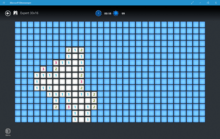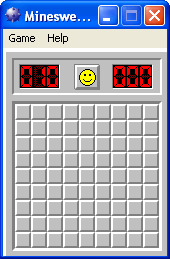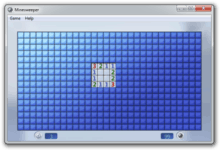Microsoft Minesweeper
| Microsoft Minesweeper | |
|---|---|
 Microsoft Minesweeper from Windows Store | |
| Developer(s) |
|
| Publisher(s) |
|
| Platform(s) |
|
| Genre(s) | Minesweeper (puzzle) |
| Mode(s) | Single player |
Microsoft Minesweeper (formerly Minesweeper) is a minesweeper computer game created by Curt Johnson, originally for OS/2, and ported to Microsoft Windows by Robert Donner, both Microsoft employees at the time. First officially released as part of the Microsoft Entertainment Pack 1 in 1990, it was included in the standard install of Windows 3.1 in 1992, replacing Reversi from Windows 3.0.[1] Microsoft Minesweeper has been included without a major change in all subsequent Windows releases until Windows Vista, at which time an updated version by Oberon Media replaced it.[2] In Windows 8 and later the game is not included, but Microsoft Studios published an updated version of it, developed by Arkadium, on Windows Store.[3][4][5]
Gameplay

The goal of the game is to uncover all the squares that do not contain mines without being "blown up" by clicking on a square with a mine underneath. The location of the mines is discovered by a process of logic. Clicking on the game board will reveal what is hidden underneath the chosen square or squares (a large number of blank squares may be revealed in one go if they are adjacent to each other). Some squares are blank but some contain numbers (1 to 8), each number being the number of mines adjacent to the uncovered square. To help avoid hitting a mine, the location of a suspected mine can be marked by flagging it with the right mouse button. The game is won once all blank squares have been uncovered without hitting a mine, any remaining mines not identified by flags being automatically flagged by the computer. However, in the event that a game is lost and the player mistakenly flags a safe square, that square will either appear with a red X covering the mine (denoting it as safe), or just a red X (also denoting it as safe). The game board comes in three set sizes: beginner, intermediate, and expert, though a custom option is available as well.[6]
In early versions of the game, a cheat code let players peek beneath the tiles.[7]
The original game has been given the name of Flower Field instead of Minesweeper in some translations of Windows, featuring flowers instead of mines.[8] Flower Field gameplay is otherwise unchanged, as is the executable file name.
Development

In 2003, Microsoft created a variation called Minesweeper Flags in MSN Messenger, which is played against an opponent with the objective to find the mines rather than the surrounding squares.[9]
The game's color scheme changed with the release of Vista (from gray to either blue or green). The icons were updated to match the Aero look. It also came with a more peaceful "flower" motif to replace the landmines.[1] This iteration of Minesweeper was created by Oberon Media.
Microsoft removed Minesweeper from Windows 8 and instead published a free equivalent on its Microsoft Store (digital). The new version is developed by Arkadium and is ad-supported.[10][11] The initial release was supported by 30 second video ads. Later releases had monthly and annual subscription options to remove the ads.[12][13][14] Multiple news outlets criticized the change as greedy.[15][16][17][18] This version updates both motifs. Daily challenges and an adventure mode were also added.
Reception
Business Insider called the game an "iconic part" of the Windows operating system.[19]
References
- 1 2 "Column from Tony "Tablesaw" Delgado about puzzle games". Gamesetwatch.com. 2007-02-26. Retrieved 2011-06-22.
- ↑ Cobbett, Richard (2009-05-05). "The most successful game ever: a history of Minesweeper". TechRadar. Future US. Retrieved 2011-06-22.
- ↑ "Microsoft Minesweeper". Microsoft Studios.
- ↑ "What Happened to Solitaire and Minesweeper in Windows 8?". How-To Geek.
- ↑ "You Don't Have to Pay $20 a Year for Solitaire and Minesweeper on Windows 10". How-To Geek.
- ↑ "Minesweeper: how to play". Windows. Microsoft. Archived from the original on September 10, 2015. Retrieved January 20, 2017.
- ↑ Leonhard, Woody (2007). Windows Vista all-in-one desk reference for dummies. Wiley. p. 342. ISBN 0-471-74941-9.
- ↑ Flower Field game in Italian version of Windows 2000.
- ↑ "Minesweeper Flags tips?".
- ↑ Rambo, Dant (15 October 2012). "Arkadium on revamping Solitaire, Mahjong, and Minesweeper for Windows 8 [Interview]". Gamezebo. Retrieved 10 August 2013.
- ↑ Orland, Kyle (27 October 2012). "The new and updated games of Windows 8". Ars Technica. Retrieved 10 August 2013.
- ↑ Hay, Richard. "Microsoft Adds Premium Subscriptions to Windows 8 Games to Remove Ads. Could Built In Apps be next?". Windows Observer.
- ↑ Kamen, Matt (30 July 2015). "Windows 10 makes you pay to remove ads from Solitaire". Wired UK.
- ↑ "Windows 10: You'll need to pay for Solitaire". Sky News. August 1, 2015. Archived from the original on August 4, 2015. Retrieved January 20, 2017.
- ↑ Walker, Alissa (July 29, 2015). "If You Want Microsoft Solitaire Ad-Free It'll Cost You $10/Year". Gizmodo. Gawker Media. Retrieved January 20, 2017.
- ↑ Chalk, Andy (July 29, 2015). "Windows 10 Solitaire requires a subscription to remove ads". PC Gamer. Future plc. Retrieved January 20, 2017.
- ↑ "Windows 10: Now you have to pay to play Solitaire". Telegraph.co.uk. 31 July 2015.
- ↑ Meer, Alec (July 30, 2015). "How To Stop Windows 10's Spying Ads". Rock, Paper, Shotgun. Retrieved January 20, 2017.
- ↑ Weinberger, Matt (August 18, 2015). "Bill Gates was so addicted to Minesweeper, he used to sneak into a colleague's office after work to play". Business Insider Australia. Allure Media. Retrieved January 20, 2017.
Further reading
- Kaye, Richard (March 2000). "Minesweeper is NP-complete!". Mathematical Intelligencer. 22 (2): 9–15. ISSN 1866-7414.